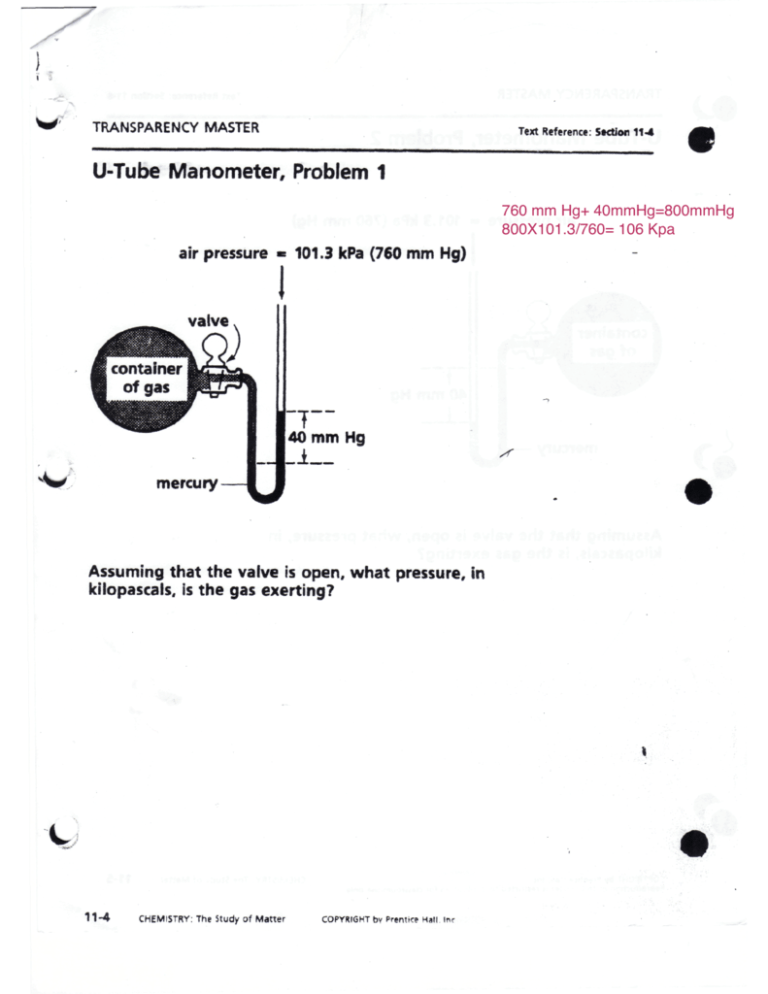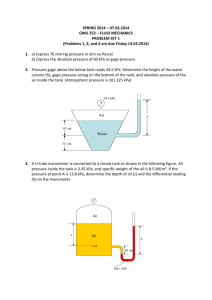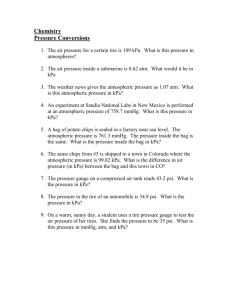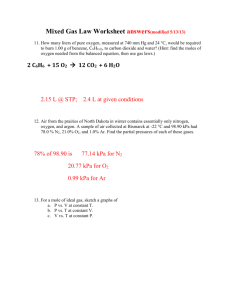U-Tube Manometer Problems: Chemistry Transparency Master
advertisement

TRANSPARENCY MASTER Text Reference: Section 11-4 U-Tube Manometer, Problem 1 760 mm Hg+ 40mmHg=800mmHg 800X101.3/760= 106 Kpa air pressure « 101.3 kPa (760 mm Hg) valve i container of gas mercury Assuming that the valve is open, what pressure, in kilopascals, is the gas exerting? • 11-4 CHEMISTRY: The Study of Matter COPYRIGHT by Prentice Hall Inr TRANSPARENCY MASTER Text Reference: Section 11-4 U-Tube Manometer, Problem 2 air pressure * 101.3 kPa (760 mm Hg) i 760mmHg- 40mmHg = 720mm Hg container of gas 720 mmHg x 101.3 Kpa/760 mmHg= 95.96 Kpa mercury Assuming that the valve is open, what pressure, in kilopascals, is the gas exerting? ^ COPYRIGHT by Prentice Mill, Inc. Reproduction of thu matter n reitncted to duplication for claiiroom u»e only CHEMISTRY: The Study of Matter 11-5 — TRANSPARENCY MASTER - * '\ ' Text Reference: 'Section 11-4 «T*. , U-Tube Manometer, Problem 3 air pressure in open end P atm 1. When the valve is opened, will the mercury in the UP right arm of the U-tube move up or down? 2. After the mercury stops moving, what will be the 104.4 Kpa -99.75 Kpa= 4.65 Kpa difference in height of the mercury levels in the two arms of the tube? 4.65Kpa x 760 mm Hg/ 101.3Kpa = 34.89 mm Hg 11-6 CHEMISTRY The Study of Mattel COPYRIGHT by Prennce Hall, Inc Measuring Pressure Barometers and open-ended manometers are devices used to measure pressure. In a barometer, the height of a column of mercury (in millimeters) equals the atmospheric pressure, in millimeters of mercury. (1 mm Hg = 0.133 kPa). The tube of an open-ended manometer is open, at one end, to the atmosphere. Therefore, atmospheric pressure is being exerted on the column of mercury in that arm of the tube. If the height of the mercury in the open arm is greater than that in the other arm, the difference between the two heights must be added to the atmospheric pressure to find the pressure of the confined gas, in mm Hg. If the height in the open arm is Jess than that in the other arm, the difference in height must be subtracted from the atmospheric pressure. After you have calculated the pressure in millimeters of mercury, convert the answer to kilopascals by multiplying by the conversion kPa factor 0.133 —. mm Hg Refer to the figures below in answering the following questions. equals atmospheric pressure = 101.3 kPa 760 mm atmospheric pressure = 100.4 kPa atmospheric pressure = 101.7kPa Hg 750 mm / confined ^—s confined V 600 mm V 9 S * 325 mm< 175 mmHg 500 mm 400mmHg 150 mm (0 1. What is the atmospheric pressure, in kPa, indicated by the barometer in Figure A? 2. What is the pressure, in kPa, of the confined gas as indicated by the open-ended manometer in Figure B? 750 mm X 101.3 Kpa/760 mm = 99.97Kpa 1. 2. 400mmHg + 760 mmHg= 1160 3. What is the pressure, in kPa, of the confined gas indicated by the 3. (175mmHg X 101.3 Kpa/760 mmHg760) 100.4 Kpaopen-ended manometer in Figure C? = 77.7 + Kpa 4. What is the pressure, in kPa, of the confined gas indicated by the 4. open-ended manometer in Figure D? 101.7 Kpa + (400 mmHg x 101.3 Kpa/760 mmHg) = 155 Kpa







